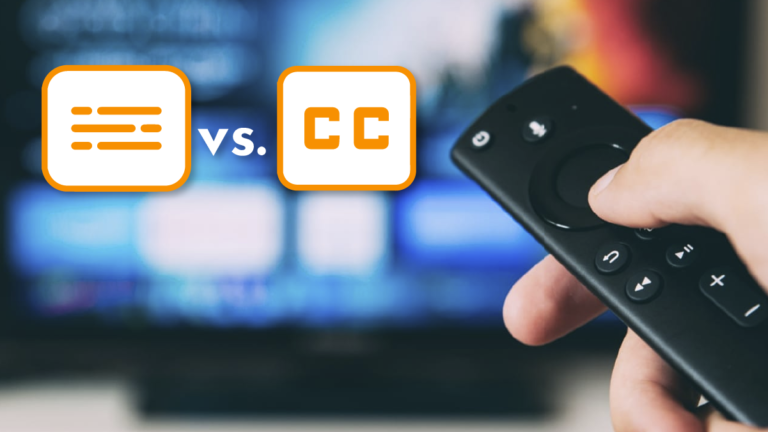¿Cuál es la diferencia entre subtítulos y captions?

Imagina que estás en casa, relajándote, a punto de ver un vídeo en YouTube o en una plataforma similar, y antes de empezar quieres activar los subtítulos en la pantalla. Sin embargo, cuando accedes a la configuración disponible para el vídeo, te encuentras con dos opciones que parecen idénticas: subtítulos y captions. ¿Cuál necesitas?
Aunque parezcan términos equivalentes, como ya habrás imaginado, no lo son. Ambos designan la idea de expresar en texto lo que se escucha en el audio de un vídeo, pero tienen finalidades distintas.
Para comprender mejor las diferencias entre closed captions y subtítulos, primero echemos un vistazo a la historia del cine y de dónde provienen estas técnicas. Porque para entender a quienes narran, debemos preparar el escenario.
Antes de que los subtítulos y captions tuvieran un nombre: los intertítulos
Los subtítulos son un elemento indispensable en el camino hacia la inclusión en el mundo del cine. El objetivo siempre ha sido permitir que más personas entiendan y disfruten las historias en la pantalla. Y aunque hace un siglo era un recurso con muchas limitaciones que empezó siendo exclusivo del cine, la realidad actual es muy distinta.
Hoy contamos con servicios de subtitulado profesional para garantizar textos de alta calidad que cumplan con los estándares específicos de la industria y estén presentes en todas partes, en todas las plataformas de vídeo posibles, en cualquier lugar. Aunque en el pasado, no era así.
Intertítulos
A finales del siglo XIX, el cine mudo introdujo los intertítulos, los primeros textos en pantalla que nos daban una pista de lo que sucedía en cada escena.
Si bien estaban lejos de ser como los subtítulos y captions de hoy en día, nos contaban brevemente de qué se trataba el diálogo de los personajes. Eran textos impresos en papel, filmados y colocados entre las diferentes escenas de la película. Un poco rústico, ¿no? Un poco rústico, ¿no?
El invento que marcó un antes y un después
Hacia 1901, varias personas inventoras y especialistas en dirección cinematográfica habían comenzado a experimentar con nuevos métodos, entre ellas Georges Méliès y Robert W. Paul, quienes lograron crear la primera cámara cinematográfica. Este invento hizo posible algo que revolucionó el mundo cinematográfico y significó un gran paso hacia lo que hoy conocemos como closed captions (calma, ¡falta poco para que hablemos de ello!).
En resumen, el dispositivo permitía superponer texto sobre las escenas actuadas. ¡Y voilà! La técnica se consolidó con el cortometraje Scrooge (o El fantasma de Marley) y, posteriormente, con Alicia en el país de las maravillas. A decir verdad, el resto es historia.
#OptimationalTip: al comprender la diferencia entre closed captions y subtítulos, puedes abordar tu estrategia de contenido de vídeo como corresponde. Usa la herramienta adecuada para el objetivo deseado.
Aunque nos encantaría seguir hablando de la historia del cine, estamos aquí para ayudarte en el crecimiento de tu negocio. De todas formas, te recomendamos un blog sobre la historia del cine, por si quieres saber más.
Subtítulos y captions: tú eliges
Parecidos, pero diferentes. Basta de suspenso, aclaremos este misterio.
Closed captions
La implementación de esta función se remonta a la década de 1970, cuando el objetivo era permitir que las personas sordas y con dificultades auditivas pudieran disfrutar de la programación televisiva. El closed caption incluye todo el audio indispensable de un vídeo, desde líneas de diálogo hasta sonidos (que normalmente vemos entre corchetes).
Una vez establecidos, los captions no se podían desactivar y formaban parte del mismo vídeo (open captions). Sin embargo, poco después surgió la técnica de closed caption, o CC, que permitía a la audiencia elegir si mostrarlos en pantalla o no.
En cuanto a su apariencia, podemos distinguir entre subtítulos y captions porque estos últimos se caracterizan por la presencia de letras blancas superpuestas sobre un fondo negro.
Subtitulado
La incorporación de subtítulos comenzó en la década de 1930, con la transición del cine mudo al cine sonoro. Este hecho representó un desafío nuevo: ¿cómo conseguir que la audiencia extranjera comprendiera los discursos?
Sin alterar el idioma hablado (que sería el doblaje, tema para analizar en otro momento), el discurso traducido se añade por escrito. La solución óptima en este caso es contar con servicios de subtitulado profesional que garanticen la fidelidad de la interpretación, la sincronización temporal y el seguimiento de las mejores prácticas de subtitulado del mercado.
En cuanto a sus mecanismos de funcionamiento, hay una diferencia entre subtítulos y captions. ste último depende de un chip codificador que se instala en el televisor, mientras que los primeros suelen estar incorporados en el vídeo. También puede tratarse de un archivo independiente que se ejecuta con el archivo de vídeo.
Con respecto a la apariencia y el aspecto, si bien mencionamos la diferencia entre subtítulos y closed captions, aclaramos que los subtítulos pueden tener distintas fuentes y colores, pero no tienen un fondo.
#OptimationalTip: quienes se especializan en el subtitulado también se centran en aspectos técnicos, como el tiempo y la sincronización, el movimiento de los labios, la localización (cuando corresponda), la longitud de las frases, etc. Consulta algunas de las pautas de subtitulado de la BBC.
¿Has analizado cuáles son las mejores prácticas para optimizar YouTube? Si aún no lo has hecho, en el siguiente enlace encontrarás información sobre las mejores prácticas de SEO para la traducción de vídeos de YouTube.
Reflexiones finales: ¿cómo contarás tu historia?
Subtítulos y captions: ¿cuáles necesitas? Puedes consultar lo que otras compañías están haciendo, en especial las plataformas de streaming. Sin embargo, la verdad es que nadie conoce las necesidades de tu negocio mejor que tú. Sabemos que en el proceso de expansión internacional puede resultar complejo encontrar la estrategia adecuada, es decir, aquella que mejor se adapte a una necesidad concreta, en un momento específico. Por eso, queremos ayudarte en todo momento a ver el panorama general y las herramientas con las que puedes contar.
Un último mensaje: si alguna vez viste subtítulos desprolijos, frases poco claras y caracteres especiales que interrumpen el flujo narrativo, no querrás que esto suceda con tus vídeos. Contáctanos hoy para que podamos ayudarte.


